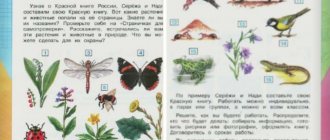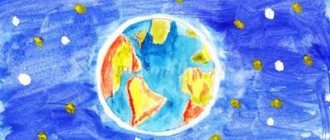Greetings, dear nature lovers! Many of you know what the Red Book is and will easily answer that it contains those animals and plants that we need to protect in order to preserve for future generations. Only a few have held this creation in their hands, few people know that it has sections of different colors; you can count on one hand the number of people who have flipped through the colored pages.
Therefore, today I propose to take a closer look at the Red Book, find out how it came into being, what species of flora and fauna are listed there, and how these rare specimens get there.
History of the Red Collection
Mother Nature tried and created her various unique living creations, but we have already lost many of them, they cannot be returned, some are on the verge of extinction.
The pilot issue of the Red Book was published in 1963. And the prerequisites for its publication were the decision to create the International Union for Conservation of Nature in 1948, which is the publisher of the international Red Book to this day.
15 years passed from the date of its formation before the first edition of the collection was published. Over the years, scientists have carefully collected data on rare animals that are on the verge of extinction. Based on this information, lists of animal representatives were compiled. International conferences were held to draw attention to the global problem and propose ways to protect rare specimens.
Peter Scott, Chairman of the Commission for the Conservation of Nature, proposed calling this global list of endangered animals the Red Book, explaining the choice of color as an SOS warning signal of danger and distress.
“Stop, don’t destroy!” - this is exactly what all the animals and plants listed in the red collection ask, attracting people’s attention to themselves in order to stop the barbaric attitude towards them.
Amphibians
There are only about 30 species of amphibians in Russia. Of these, about a third are listed in the Red Book and are endangered. At the same time, amphibians bring enormous benefits by destroying insects that carry diseases and pests.
Triton Karelina
One of 6 species of the genus newts, found on the Black Sea coast and in the mountains of the Crimean Peninsula. The KKRF is listed as a species with an uncertain status. It is protected in the Caucasus Nature Reserve (about 200 individuals). Population numbers are declining due to the draining of water bodies.
Triton Karelina
Reed toad
In the country, the reed toad is found in the Kaliningrad region. The risk of extinction of the species is minimal, but human activity has a negative impact on the population. The amphibian is characterized by a variety of habitat conditions. It can live both in dry, warm areas and on wet coasts. The average density of the species is up to 10 individuals per hectare.
Reed toad
Ussuri clawed newt
Distributed in the Far East of the country, where it inhabits coniferous and mixed forests. It feeds on mollusks and insects. The main thing for this species of newts is the presence of suitable living conditions. It needs moisture, coolness and shaded areas.
Ussuri clawed newt
The species' abundance is assessed as low, with a slight increase in some areas. Protected in several nature reserves.
Evolution of the Red Book
The very first trial release included mammals (211 species were counted) and birds (312 species in total). The pilot publication looked like a desk calendar of decent thickness, was released in a small, limited edition and was sent to scientists, government officials and environmental agencies. Any leaf of the book could be replaced with a new one if the information changed.
Over the 5 years from 1966 to 1971, the second edition of the Red Book was published in three volumes, which already had a book format measuring 21*14.5 cm. The second issue was noticeably replenished with the number of rare copies included thanks to the updated information collected. Year after year, the book was replenished with fresh descriptions, and in the third edition, released in 1972, it already included:
- 528 mammals;
- 619 birds;
- 153 reptiles.
Now its page categories began with a description of the state of the species at the current moment, then a description of the geography of its habitat was given, the population and the number of surviving representatives were described, it contained information about current protection measures and proposals for preserving the species in nature. But unlike its predecessors, the third edition was released for free sale, so its circulation was significantly increased.
The fourth edition of the International Red Book was published from 1978 to 1980, “in the image and likeness” of the previous one. It contained information about seven restored species of mammals, four preserved species of birds, and two rescued species of reptiles.
Today, work on the International Red Book does not stop, because it has no expiration date, because more and more new representatives of the animal and plant world may end up on its pages under threat of extinction. This is not a law about nature, these are just facts collected by scientists. But it is the colored pages of the Red Book that force us to pay attention to the global problem of our planet.
In addition to the international book of the Union for Conservation of Nature, many countries currently have their own Red Books of animals and plants. Russia also has such a collection, which consists of two volumes:
- one is about animals;
- the other is about plants.
The final version was published in 2001 at 860 pages. In addition, many Russian regions and territories have their own regional collections of rare specimens of flora and fauna.
Mammals
The list of mammals in Russia includes about 300 species. Of these, several dozen representatives of the animal world are included in the KKRF. They belong to the following groups:
- Predatory;
- Insectivores;
- Chiroptera;
- Rodents;
- Cetaceans;
- Pinnipeds;
- Artiodactyls;
- Odd-toed ungulates.
Amur tiger
The Amur or Far Eastern tiger lives in the southeastern part of Russia. This is a protected area spreading along the banks of the Ussuri and Amur rivers. According to the 2015 census, the number of these animals was 523-540 individuals.
Amur tiger
For example, in 2013 there were fewer tigers - 450. The main reason for the extinction in the 19th century was human activity - every year the number of tigers decreased by an average of 100 individuals.
Experts plan to resettle Amur tigers in the area of the Pleistocene Park (Yakutia).
Then it will be possible to increase their population to 75 individuals. But for this it is necessary to increase the population of artiodactyl animals, which form the basis of the tiger’s diet. In addition to deer, roe deer, and moose, they feed on small animals, birds, and fish. Tigers need about 10 kg of meat per day. Interesting fact : the Amur tiger is the only subspecies that has a 5 cm thick layer of fat on its belly. It helps animals survive even at very low temperatures.
Far Eastern leopard
Amur leopard, East Siberian leopard - this predator has up to 5 names. It is considered the rarest subspecies. According to 2022 data, 87 individuals live in Russia. Their habitat is the Land of the Leopard National Park.
Far Eastern leopard
The decline in the number of Far Eastern leopards is associated with poaching. This includes the animals that these predators feed on. People are also destroying forests, a natural habitat. Due to the small number of the species, leopards reproduce within the same population, which has a bad effect on genetics.
The predator is nocturnal and hunts alone. The diet consists of other animals of any size, mainly ungulates. Large prey lasts a leopard about a week.
Snow leopard (irbis, snow leopard)
A large predator from the cat family, it is common in the mountains of Central Asia. In Russia these are Altai, Tuva, Krasnoyarsk Territory, Khakassia, Buryatia, and the Eastern Sayan mountain system. Due to the difficult conditions in which the snow leopard lives, it is one of the least studied species of its family. Perhaps the snow leopard population has not completely disappeared precisely because of its habitat.
Snow Leopard
According to estimates in 2022, the number of snow leopards in Russia is 63-64 individuals, of which there were more than 10 kittens. Evidence suggests that the population remains relatively stable. 2-3% of the total number of snow leopards live on the territory of the Russian Federation.
Officially, hunting snow leopards is prohibited. However, poaching continues to harm their population. Predators also suffered as a result of mass poisoning of rodents, which are part of their diet, with pesticides. Snow leopards lead a predominantly solitary lifestyle, but family groups are sometimes found. They feed on ungulates and small animals.
Central Asian leopard or Caucasian leopard
In Russia it is found in the North Caucasus. The Central Asian leopard lives in forests and dense bushes, preferring to stay close to rocks and stones. Predators feed on medium-sized ungulates (deer, mouflon, wild boar, etc.), and sometimes on small animals.
Central Asian leopard
The problem of the population of Caucasian leopards is more than relevant. There are about 1000 of them preserved in the world. The main cause of extinction is human activity. The exact number of animals within the Russian Federation has not been established. However, in 2007, a special program was approved to restore the leopard population in the Caucasus.
Sea lion
The sea lion or northern sea lion is the largest species in the eared seal family. Belongs to the second category of animals, that is, those whose numbers are declining. In Russia, sea lions began to noticeably disappear in 1890-1990 - from 115,000 to 15,000 individuals. According to the latest data, their population in Russian waters is about 20,000.
Interesting: Climate: what it is, description, types, features, photos and videos
Sea lions
Animals are found in the waters of the Sea of Okhotsk, Bering, and Japan, as well as along the Kuril Islands and Eastern Kamchatka. Sea lions prefer coastal areas and islands. Their life cycle consists of migrations and rookery periods.
The exact reason for the decline in the number of northern sea lions has not been established. Main factors: fishing, water pollution, warming, catching fish, which forms the basis of the diet of sea lions. Steller sea lions also have natural enemies - killer whales and brown bears.
Walrus
Walruses are the only representatives of their family. Juveniles are easy to distinguish from adults: the latter have huge tusks. According to the main classification, these pinnipeds are divided into Pacific and Atlantic. Another subspecies is the Pacific Laptev walrus.
Walrus
Interesting fact : the walrus is the largest species in the group of pinnipeds after the elephant seal. However, walruses and elephant seals are not found in the same areas, so the walrus family can be called the largest in its range.
The Atlantic and Laptev walruses are listed in the KKRF. The population of the first species in Russia is about 20 thousand, the second – up to 10 thousand individuals. In the case of the Atlantic walrus, the number of individuals was significantly reduced due to uncontrolled fishing. The population is also affected by climate change, natural enemies, and parasites.
Walruses live in the waters of the Chukchi, Bering, Kara, East Siberian, and Laptev Seas. They prefer coasts and do not move long distances.
harbor seal
The common seal is a predatory mammal, two subspecies of which (European and Kuril) are listed in the Red Book of Russia. Seals are common in the seas belonging to the Arctic Ocean. They live in the coastal zone, bays where strong winds do not blow. There is also a population of seals on the Commander Islands.
harbor seal
The number is declining for several reasons: poaching, global warming, human activity in the coastal zone, attacks by natural enemies (polar bears, killer whales). The number of individuals has recently been 4-6 thousand.
Narwhal
The narwhal is the only representative of its genus. It is included in the 3rd category of animals, as a rare species with a small number of individuals. The exact number of narwhals is unknown, but in 2022 scientists discovered about 30 individuals, including calves.
Narwhal
The usual habitat is the waters of the Arctic Ocean and the northern part of the Atlantic. Narwhals suffer most from poaching, as well as from natural predators - killer whales, polar bears, polar sharks.
bottlenose dolphin
The bottlenose dolphin (large dolphin) is a species of dolphin. There are several of its subspecies. In particular, the Black Sea bottlenose dolphin, which lives in the waters of the Black Sea (about 7 thousand individuals), is listed in the Red Book of Russia.
bottlenose dolphin
Since 1996, fishing for these dolphins has been prohibited. Bottlenose dolphins are disappearing for many reasons: fishing, netting, poaching, pollution of ocean waters with household waste, noise pollution.
Bottlenose dolphins prefer a sedentary lifestyle or move in small groups. As a rule, they live near the coast, which is explained by the nature of their diet. The diet of dolphins includes a variety of fish.
Interesting fact : a characteristic feature of bottlenose dolphins is their well-developed cognitive abilities. For example, they understand gestures, monitor their behavior, imitate people, etc.
Blue whale
The blue or blue whale belongs to the category of baleen whales. It is both the largest representative of cetaceans, and also, apparently, the largest animal that has ever lived on the planet (up to 33 m in length and weighing more than 150 tons).
Blue whale
Among the three subspecies, the northern blue whale is listed in the CCRF. It is considered typical because it was the first discovered and described. In general, blue whales are considered cosmopolitan - that is, widespread. However, they are rare in Russian waters. For example, near Cape Lopatka (Kamchatka).
The greatest threat to whales has become active fishing, which has been officially prohibited since 1966. The exact number of individuals is difficult to establish - different sources provide conflicting data. If in the 19th century the number was several hundred thousand, now it is up to 5000.
Currently, blue whales are suffering due to collisions with ships, water pollution, and increased noise levels. They also get entangled in nets.
Polar bear
The polar bear ranks second among the largest land predators (after the saltwater crocodile). Within the Russian Federation, the species is distributed in the waters of the Bering and Chukchi Seas, as well as on the Arctic coast of the Chukotka Autonomous Okrug. This is where the largest population in the world is concentrated.
Polar bear
Polar bears feed on marine mammals. They lead a solitary lifestyle. The animals are threatened by poaching, since hunting them has been prohibited in the Russian Federation since 1956. At the same time, polar bears have low reproductive potential. The number of species in our country is up to 7000.
Interesting: Ecological system






